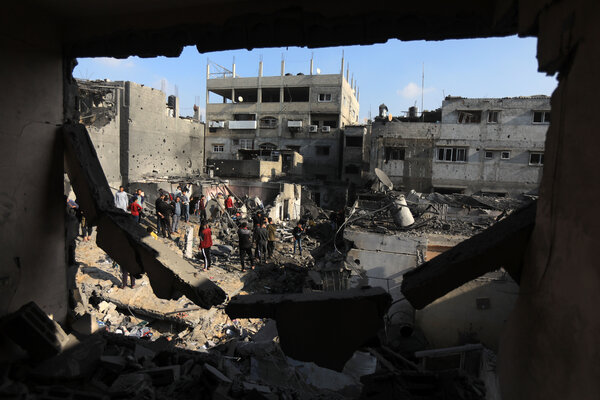
After a week of calm, Yousef Hammash woke up in the southern Gaza city of Rafah on Friday to the booming sounds of explosions. The brief feeling of safety he had felt was over, he thought.
“Seven weeks of madness have been followed by seven days of humanitarian pause,” Mr. Hammash, the Norwegian Refugee Council’s advocacy officer in Gaza, said in a voice message. “And now, we are back to the cycle of violence again.”
The region’s fragile, seven-day truce collapsed early Friday, and Gaza was once again pummeled as Israel resumed one of the most intense bombing campaigns of the 21st century. In the following hours, Gazan health officials said, 178 Palestinians were killed and another 578 people were wounded.
The deal for the truce struck by Israel and Hamas, which went into effect on Nov. 24, had allowed for the release of 240 imprisoned Palestinians and 81 hostages taken by Hamas and other militant groups on Oct. 7. Another two dozen foreigners, mostly Thai agricultural workers, were also freed under negotiations separate from the cease-fire arrangement.
The truce also allowed for a larger number of deliveries of humanitarian aid and fuel to Gaza than in previous weeks of the war.
Israeli and Hamas officials said the deal collapsed because they could not agree on additional exchanges of hostages and Palestinian prisoners and detainees. Israel and Hamas also blamed each other for violating the cease-fire.
Mr. Hammash said that the Norwegian Refugee Council, a nongovernmental group based in Oslo, had used the temporary cease-fire to prepare a plan for aid distribution. But with the resumption of the fighting, he said, his teams have ceased operations.
The latest phase of Israel’s campaign against Gaza is expected to target the southern half of the region, where many Palestinians have sought safety.
Some Palestinians located near Khan Younis said the Israeli military was directing them to evacuate further south, to Rafah, which lies along Gaza’s border with Egypt. But that city has also been hit by airstrikes. Many Palestinians and observers maintain that nowhere in Gaza can be considered safe.
Mahmoud el-Khaldi, a 17-year-old from Gaza City, sustained a fractured skull and experienced bleeding in his lungs, liver and spleen from Israeli airstrikes on Nov. 20 in Rafah that killed his sister, Carolin el-Khaldi, 28. He was discharged from the Gaza European hospital on Thursday, and went to his aunt’s house in Al Qarara, a few miles north of Rafah, near the city of Khan Younis.
Early on Friday, thundering Israeli airstrikes hit nearby homes, blowing out the windows at his aunt’s and injuring Mr. el-Khaldi again, this time lightly.
“As soon as the truce ended, they struck homes near us,” Mr. el-Khaldi said in a phone interview on Friday evening. “It was a sound of horror.”
Mr. el-Khaldi said that the Israeli army had ordered his family to leave Al Qarara and move back to Rafah. His family, however, has refused.
Sameer al-Jarrah, 67, has been living in Al Qarara since the war began on Oct. 7, following the devastating Hamas-led attacks on Israel launched from Gaza.
“I don’t know where to go,” he said. Asked if Rafah was a possibility, he said, “Where people will go, I’ll go.”
At least 1.8 million residents, or 80 percent of Gaza’s population of some 2.2 million, have been forced to flee their homes since the war. Many fear permanent displacement.
Gheed al-Hessi, 37, moved to Rafah from northern Gaza in October, when the Israeli military ordered a mass evacuation that sent hundreds of thousands fleeing south. But to describe the south as the safest or most humanitarian area in Gaza is a “very big lie,” she said.
Huge explosions late at night and in the early morning often wake her, leaving her shocked and trembling. She said she had run out of clean water, cooking gas and electricity.
“Rafah is not safe at all,” she said. “Since the very beginning of the war, many, many buildings and many families were hit.”
She said a friend had called her on Friday and asked if there was anywhere she could go in Rafah; Ms. al-Hessi responded that the situation was dire, with many forced to sleep outside on the pavement or in nylon tents.
People in Rafah, she added, were preoccupied with one question.
“If the Israeli forces threaten us and ask us to evacuate and to leave Rafah,” she said, “where are we going to go?”
This post was originally published on this site be sure to check out more of their content.






